 полная версия
полная версияPicturesque Pala / The Story of the Mission Chapel of San Antonio de Padua Connected with Mission San Luis Rey
Now it must be bought back again. There were 3,500 acres, with a large amount of hilly government land that would be of use for pasturage and that could be added to the full purchased land as a reservation. The Commission claimed, and doubtless believed, there was plenty of water, but it was not long before the supply was found to be so inadequate that something had to be done to add to it. This has been done, as is elsewhere related.
Congress passed the appropriation bill, made the purchase, May 27, 1902, setting the land aside as a permanent reservation. The Indian Department, therefore, ordered the immediate transfer of the Indians from Palatingua, as well as small bands from Puerta de la Cruz, Puerta Chiquita, San José, San Felipe and Mataguaya—tiny settlements on the fringe of Warner's Ranch and who were made parties to the ejectment suit—to Pala.
Serious trouble was feared. Mr. Lummis wired for troops to aid in the removal, although his duties as head of the Commission to choose a home for the Indians gave him no authority to act in the matter. He was thereupon ordered from the ranch, and the work of removal committed to the care of a special agent, as Dr. L. A. Wright, the regular Indian Agent, confessed his inability to cope with the situation. Mrs. Babbitt, for many years the teacher at Warner's Ranch, and other friends of the Indians counselled acquiescence to the law's demand. I was invited both by the Indians and the Indian Commissioner to be present at the removal, but I knew that it would be too much for my equanimity, so I kept away. My friend Grant Wallace, however, was present, and in Out West magazine, for July, 1903, gave the following pathetic account:
Night after night, sounds of wailing came from the adobe homes of the Indians. When Tuesday (May 12) came, many of them went to the little adobe chapel to pray, and then gathered for the last time among the unpainted wooden crosses within the rude stockade of their ancient burying ground, a pathetic and forlorn group, to wail out their grief over the graves of their fathers. Then hastily loading a little food and a few valuables into such light wagons and surreys as they owned, about twenty-five families drove away for Pala, ahead of the wagon-train. The great four and six-horse wagons were quickly loaded with the home-made furniture, bedding and clothing, spotlessly clean from recent washing in the boiling springs; stoves, ollas, stone mortars, window sashes, boxes, baskets, bags of dried fruit and acorns, and coops of chickens and ducks.
While I helped Lay-reader Ambrosio's mother to round up and encoop a wary brood of chickens, I observed the wife of her other son, Jesus, throwing an armful of books—spellers, arithmetics, poems—into the bonfire, along with bows and arrows, and superannuated aboriginal bric-a-brac. In reply to a surprised query, she explained that now they hated the white people and their religion and their books. Dogged and dejected, Captain Cibemoat, with his wife Ramona, and little girl, was the last to go. While I helped him hitch a bony mustang to his top buggy, a tear or two coursed down his knife-scarred face; and as the teamsters tore down his little board cabin wherein he had kept a restaurant, he muttered, "May they eat sand!"…
At their first stop for dinner they lingered long on the last acre of Warner's Ranch, as though loath to go through the gates. At night, at Oak Grove, they drew the first rations ever issued to the Cupenos by the government—some at first refused to accept them, saying they were not objects of charity....
Although devout church members—scarcely a name among them being unwashed by baptism—they refused the first Sunday to hold services in the restored Pala Mission, or anywhere else, asking surlily of the visiting priest, "What kind of a God is this you ask us to worship, who deserts us when we need him most?" Instead, thirty of them joined some swart friends from Pauma in a "sooish amokat" or rabbit hunt, killing their game with peeled clubs thrown unerringly while galloping at full speed.
Monday, however, the principal men, better pleased after an inspection of the fertile and beautiful valley of Pala, had a flag-raising at the little school-house—the only building now on the site of the projected village. An Indian girl played the organ, and a score of dusky children—who will compare favorably in intelligence with average white youngsters—joined in singing the praises of "America—sweet land of liberty." School was opened, and later a policeman—young Antonio Chaves—was elected by popular vote.

The Pala Chapel and Campanile After Restoration by the Landmarks Club.
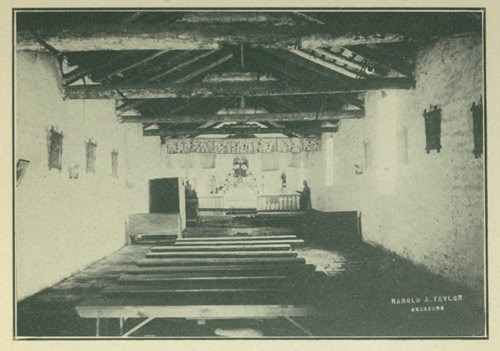
The Interior of Pala Chapel as it Appears Today.
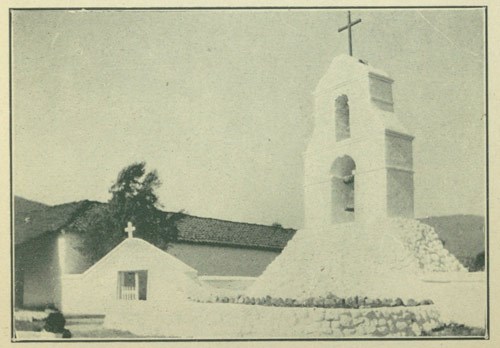
The Pala Bell Tower After Rebuilding.
Thus came about the transfer of the Palatinguas to Pala. Though they often longed for their old home it could not be denied, even by them, that the location of Pala is ideal. It is literally surrounded by mountains that seem to rise in huge overlapping rings, each circling the diminutive valley. The Pala River flows through the settlement. Almost every available foot of space is now under cultivation in that part of the valley near by, and further down, along the river, where the fields broaden out, many acres are yielding their rich and valuable crops.
To the south may be seen the hospitable ranch-house—Agua Tibia—of Lewis Utt, an attorney of San Diego, who divides his time between his city office and his farm. Five thousand feet above cluster the pine trees, the live oaks and other rich arboreal growths of Palomar, the Mountain of the Dove. Nearby the rich olive orchards of John Fry stretch out like silken flags of green. To the north, on the top of the Pala grade, the Happy Valley ranch of A. M. Lobaugh is a stopping-place for camper and tourist. To the west is the extensive ranch of Monserrate.
There are few more beautiful inland locations in the world, and climatically it is as perfect as it is scenically. For from the one side come the breezes of the warm South Pacific ocean, laden with the ozone and bromine of kelp-beds and with the refreshing tang of the salt air, while from the other come the aseptic breezes of the desert, God's great purifying laboratory, where, after being completely purified, they are sent over the mountains, there to gather their unseen but never-the-less beneficent and healthful burden of sweet balsams and odors from the trees, shrubs and blossoms that glorify their slopes and summits.
For awhile after their arrival at Pala they dwelt in tents, and then occurred one of those inexplainable and inexcusable pieces of folly that fills the heart of an intelligent man with contempt and almost with despair. Cold weather was coming on. The Indians must be housed erelong. One would have thought the sensible and obvious thing to do would have been to engage the unoccupied Indians—for, of course, none of them as yet had a thing to do—either to make adobe brick and build their houses of them, or to buy lumber for the purpose from the nearest place of supply. Instead of that what was done by the dunder-headed officials at Washington? Even as I write it seems so incredible that I can scarce believe it. These incompetent men purchased, in New York, fifty flimsy, rickety, insecure, wretched "portable" houses, sent them by freight, and ordered them put up as the permanent homes of these unfortunate exiles. The amount of money expended in these contemptible pretences for houses, and the freight paid on them from the East, would have erected permanent buildings and at the same time have provided paying occupation for the Indians during their erection. Official stupidity seldom manifested itself more clearly than in this instance.
Commenting upon the matter the government's own special agent reported:
It was nearly six months before the Indians got into the houses. The expense was double what wooden cabins built on the spot would have been, and about four times the cost of adobes.... The houses are neither dust-proof, wind-proof, nor water-proof, and are far inferior to the despised adobes.
But the Indians made the best of them, and have gradually improved, or replaced them with something better. Then the water question arose. There was not enough for their needs. Eighteen thousand dollars was first expended, and then more was called for. At last, in May, 1913, the new irrigation system was completed, and a grand fiesta was held to celebrate the opening.
The first teacher of the Palatinguas when they were removed to Pala was Mrs. Josephine H. Babbitt, who for many years had been their trusted friend at Warner's Ranch. But in those trying early days when nerves were frayed, dispositions frazzled, and passions easily aroused, her earnest and determined efforts to secure for her wards as great a meed of justice as possible rendered her persona non grata to some whose influence was powerful enough to secure her removal.
But it was not long before even this misfortune was made to work out for the good of the Indians. Miss Ora Salmons, who was a teacher of one of the near-by Indian schools, was appointed, and this year of our Lord, sees her close her twenty-eighth year of faithful and happy service among her dusky wards, many of which have been spent here at Pala. With heart, mind and body attuned to her work she has truthfully and poetically been termed "the little mother of the Indians." Radiating brightness, sunshine, sympathy and love for her pupils, old and young, she is strengthened in her daily task by the assurance that she is making their life easier and happier, removing some of the obstacles to their progress, and adding factors of strength and self-reliance to their characters.
CHAPTER X.
The Old and New Acqueducts
In Southern California water is an essential element in nearly all agricultural and horticultural development. In their own primitive fashion the Indians irrigated the lands long prior to the coming of the Spaniards. When Padre Peyri, however, came to Pala, his far-seeing eye at once noted its possibilities, and he set about bringing water from the headwaters of the river. He laid a line for a ditch from the mountains to the mission lands so accurately and with such consummate skill that it is as much the marvel of modern irrigation engineers as is the architecture of the Missions of the modern architect.
Where necessary a ditch was built, and on the other hand where the natural course was in the proper line this was followed, to be replaced again with ditches when necessary. So long as Peyri remained the ditch was in constant use, but after he left in 1832 it began to decline, and when his successor, Zalvidea, died, in 1846, it fell into disuse and soon became choked up, ruined, and useless.
When the Palatinguas came, some work in the bringing of water was done on their behalf, but it was not adequate. While it supplied the necessary water for their lands on the south side of the river, they also needed it on the north side. So the Indian Department was again appealed to, the appropriation made, and, in due time, the work begun. The government engineers found that the line of old ditch could not be improved upon, so the Indians were engaged to do the major part of the work, as they had been in the days of Peyri, and on the occasion of its completion the event was deemed of such importance that the Indians decided to hold a great fiesta.
After the decline of the Mission establishments the annual fiestas of the Indians became mere pretexts for debauchery, gambling, and the performance of their ancient dances. But of late years strenuous efforts have been made to prohibit the sale of liquor to the Indians, and the government also has abolished gambling. The influence of Father Doyle and Agent Runke have been great in changing the character of the fiesta, and on this occasion the event was one of decorum, dignity, and reverent worship, as well as dancing, playing of games, and pleasure.
Not only was the securing of a permanent supply of water a cause of rejoicing. The Indians were made happy by the announcement that, at last, the government had recognized their claims to the land which they had been tilling the past ten years and granted them their patent. The announcement was made by Walter Runke, superintendent of the reservation, just after the water was turned into the new ditch.
Granting them their patent means that each Indian, whether babe, child, man or woman is given title to one and three-quarters acres of irrigated land and six acres of dry land. Much of this dry land has been put under irrigation since the first allotment. In addition, the head of each family is given two lots, one for his house and one for his stable. There is, however, a stipulation in the grant which forbids an Indian's deeding his newly acquired property away for the next twenty-five years.
I have explained already how bitter the Palatinguas were when removed from Warner's Ranch. They felt that, as they had had no security in the possession of their homes and lands at Warner's Ranch, so would it be at Pala. They could be moved about, they said, at the whim of Washington, without a guarantee of a final competency for themselves or their children. But now they have been rewarded for their labor and patience with land in one of the most fertile and beautiful valleys of Southern California and under the shadow of the cross their beloved padre raised one hundred years ago.
The fiesta was held in due time. Eight members of the Franciscan Order from San Luis Rey were invited to take an important part in the ceremonies.
A writer in the San Diego Union shows how tenaciously the Indians cling to the ceremonies of the past. He says:
The opening of the government's new irrigation ditch was preceded the night before by the same ceremony of praise and thanksgiving that the Indians used to hold before ever a padre raised a cross among them. In a rectangular enclosure made of green willows they assembled about a log fire. They seated themselves in a circle just beyond the line of fading light, their swarthy faces being discernible only as a dim streak in the dark; but before the fire, his rough and seamed face illuminated by the unsteady flames which leaped, as now and then he picked at a brand, and revealed his audience as motionless as though chiseled out of lava, stood the aged Cecelio Chuprosa. His hands were clasped behind his back and his head bowed. At long intervals, he spoke briefly in his native tongue, his soft gutterals coming so slowly that one could count the vowels. A drawn-out low, weird monotone was the only response from that rock-like circle just beyond the light. Now and then some old woman emerged from the darkness and danced beside the burning logs while she chanted some wild incantation and was lost again in that stoic, stolid, silent circle.
Finally two padres appeared on the scene. They said nothing, but the Indians soon slunk away. The padres do not approve of the rites of pagan days, and they love their padres.
Still amid the weird savagery of that scene, there were many evidences of civilization. The old men and women wore cowhide boots and shoes which covered their feet with corns. Instead of the peace-pipe, the glow of the cigarette dawned and died everywhere through the stoic night. Oil-filled lanterns took the place of the starlight the Indians formerly used to find their way home by, and one old wabbling woman wheeled her grand-papoose to the meeting in the latest style of perambulator.
Chuprosa is 96 years old and has not a gray hair on his head. He has worn his war paint, been on the warpath, and fought in all the tribe's battles from his youth up. He is particularly proud of the valor he displayed in the battle of Alamitos, which occurred sixty-six years ago.
Now Chuprosa is a baseball fan. He roots at all the games between the teams of his and neighboring reservations. Recently he rode forty miles on horseback to Warner's Ranch to see a game and when he returned he was so stiff that he had to be lifted out of the saddle, but he rubbed his aching legs a little and laughed, for he had rooted his favorite team to victory.
Among the Franciscan monks who came from San Luis Rey to attend the Pala fiesta was another old battler who had fought through two wars and won two medals for valor from his country. One of them is the far-famed and much coveted iron-cross which German royalty and the Kaiser himself salute whenever it is seen on the breast of a veteran. But Father Damian,—and that is his only name in the cloister where he has lived now for thirty-eight years,—threw these honors into the sea and with head bowed he appeared one day at the door of a monastery and asked that he might henceforth follow only the standard of the cross.
He was given a brown robe with a cowl and a pair of sandals for his feet, and the hero of wars which Germany waged against Austria and France, lost even his name and, becoming a carpenter, gave his life in building schools and churches.
Father Damian and Chuprosa met for the first time at the Pala fiesta. The monk could speak no Spanish and the Indian no German, but they soon became interested in each other when, through an interpreter, each told of the battles the other had fought. Although seventy-two years old, the father is still rugged except that he feels the effect of cholera which attacked his regiment in the war with Austria. "One morning," he said, "one hundred in my regiment alone remained on the ground when the bugle called us. They had died overnight of cholera."

A Pala Indian Washing Clothes in the Creek.
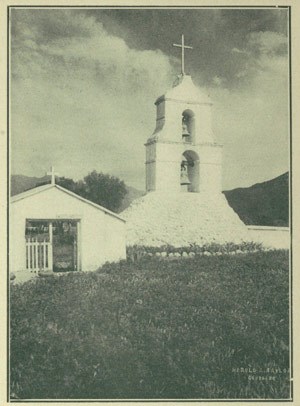
Bell Tower and Entrance to the Garden at Pala.
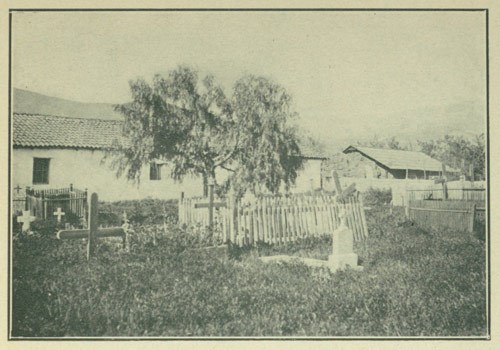
In the Pala Graveyard.
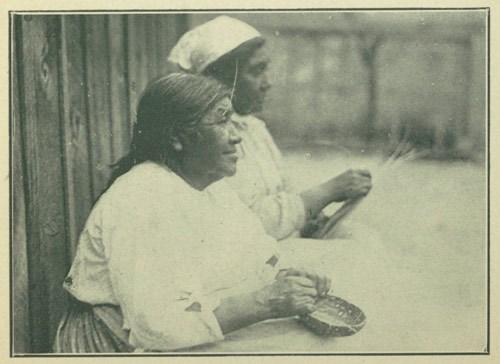
Pala Basket Makers at Work.
The morning of the fiesta dawned bright and clear. Every member of the tribe was there in his or her best. The ceremonies opened by a solemn high mass conducted by Father Doyle, and assisted by the Franciscan Fathers from San Luis Rey.
Then a grand parade was held, everyone marching happily to the head of the ditch. There Father Peter Wallischeck, Superior of the San Luis Rey house, blessed the water which poured itself for the first time over the Indians' lands since the old ditch crumbled away, and as he did so he stood on the very spot where Padre Peyri stood when, with his Indians, they said a prayer of thanksgiving over the successful completion of their labors, a century previously.
The rest of the day was then spent in the pleasures of the table mainly provided by an old-fashioned barbecue, a baseball game and the inevitable game of peon.
CHAPTER XI.
The Palas as Farmers
To many white people an Indian is always what they conceive all Indians ever have been—wild, uncultivated, useless savages. Never was idea more mistaken and cruelly ignorant. At Pala there is not an Indian on the free ration list. The putting of water upon their lands has transformed them from the crushed, disheartened, half-starved and almost despondent people they were thirteen years ago, after their removal from their beloved Palatingua, into an industrious, energetic, independent, self-supporting and self-respecting tribe.
The olive trees planted by Padre Peyri are tenderly cared for and are again in full bearing. As one now approaches Pala from either Oceanside or Agua Tibia he gazes upon a valley smiling in its dress of living green. Fields of alfalfa, corn, wheat, barley, beans, and chilis stretch out on every hand, relieved by fine orchards of apricots, peaches and olives.
For years the Indians did not take kindly to government farmers. Most of these men were too theoretical. For the past two years, however, Mr. A. T. Hammock, government farmer at Pala, has shown by example and sympathetic work the benefits of intensive farming. His practical lessons have brought many dollars into the pockets not only of the Palatinguas, but also of the other Mission Indians close to the border of the Pala reservation.
Recently the raising of late tomatoes for the Eastern market was tried with much success.
Added production enables the Indians to build better homes. Some of them have done this, as is shown in one of the illustrations, and by the time the drainage system contemplated by the government is in place many of the forlorn gift houses, erected when they first came to Pala, will be replaced by small but neat cottages.
The Palas are also successful stock raisers and have many head of cattle grazing on the wild lands of their reservation. They are also proud of their horses.
As a further evidence of progress they have now substituted for their old fiesta a modern agricultural fair.
In October, of 1915, they held their annual gathering and, after they had erected their square of ramadas, or houses of tree branches, they built one of finished lumber to contain an agricultural exhibit which consisted not only of farm products, but also preserved fruit, pastry, basketry, art lace and pottery.
Over a thousand dollars' worth of baskets and nearly a thousand dollars' worth of fine hand lace were on exhibition. Farmers from a distant county were chosen as judges and with pleased astonishment remarked that the exhibition as a whole would have taken a prize at any county fair.
Thus living with congenial administrators in a climate softer even than the city of San Diego, for the breezes of the Palomar mountains mingle with those of the Pacific in the trees which shade their humble homes; having at the end of the principal street of the village a hedged plaza, filled with blooming flowers all the year, making a frame for the old Mission chapel, which stands restored as the best preserved of the Mission chapels, a picture place of San Diego county and their place of worship; not wealthy, but having sufficient for the necessities and some of the comforts of life; it is little wonder that the Indian of Pala pursues the even tenor of his way, happy and without a care for the future.
CHAPTER XII.
With the Pala Basket Makers
The art instincts of primitive people naturally were exceedingly limited in expression. Their ignorance of tools not only restricted their opportunities for the development of handicraft ability, but also deprived them of many materials they otherwise might have used. Hence whenever an outlet was discovered for their artistic tendencies they were impelled to focus upon it in a remarkable degree. With few tools, limited scope of materials, and next to no incitement to higher endeavor as the result of contact with other peoples, they yet developed several arts to a higher degree than has ever yet been attained by the white race. One of the chief of these artistic industries was the making of baskets.
Look at one of these exquisite pieces of aboriginal workmanship and you will be astonished at the perfection of its form, its marvelous symmetry, the evenness of its weave, the suitability of the material of which it is made, its remarkable adaptability to the use for which it is intended, the rare and delicate harmoniousness of its colors, and the artistic conception of its design. These qualities all presuppose pure aboriginal work, for directly the Indian begins to yield to the dictation of the superior (!) race, she proceeds to make baskets of hideous and inartistic shape, abominable combinations of color, and generally senseless designs.
Let us watch these basket-makers at work, as we find them at Pala today. The weaver must first secure the materials. For the filling of the inner coil she gathers a quantity of a wild grass, or broom corn, the stems of which perfectly fulfil the purpose. The wrapping splints are made of three or four products of the vegetable kingdom. The white splints are secured from willows which are peeled and then split and torn apart so as to make the desired size. The thinness and pliability of the splint is determined by scraping off as much as is needed of the inside. A black splint is found in the cuticle of the martynia, or cat's claw, which grows profusely on the hill-sides. Sometimes, however, the white willow splints are soaked in hot sulphur water for several days, and this blackens them. This water is secured from one of the hot springs which are found all over Southern California. The rare and delicate shades of brown in the splints used by the Pala Indians are gained from the root of the tule. These roots are dug out of the mud of marshy places and vary in shade, from the most delicate creamy-brown to the deepest chestnut. Carefully introduced into a basket they make harmonies in color that fairly thrill the senses with delight. Now and again an added note of color is found in the red of the red-bud, which, when gathered at the proper time, gives a sturdy red, not too vivid or brilliant, but that harmonizes perfectly with the white, black and brown. As a rule these are the only colors used by the older and more artistic of the Pala weavers. Now and again, a smart youngster, trained at the white man's school, will come back with corrupted ideas of color value, and will flippantly make gorgeously colored splints with a few packages of the aniline dyes that, to the older weavers, are simply accursed. But even the most foolish and least discerning of the white purchasers of baskets made of these degraded colors cannot fail, in time, to learn how hideous they are when compared with the natural, normal and artistic work of the more conservative of the weavers.



